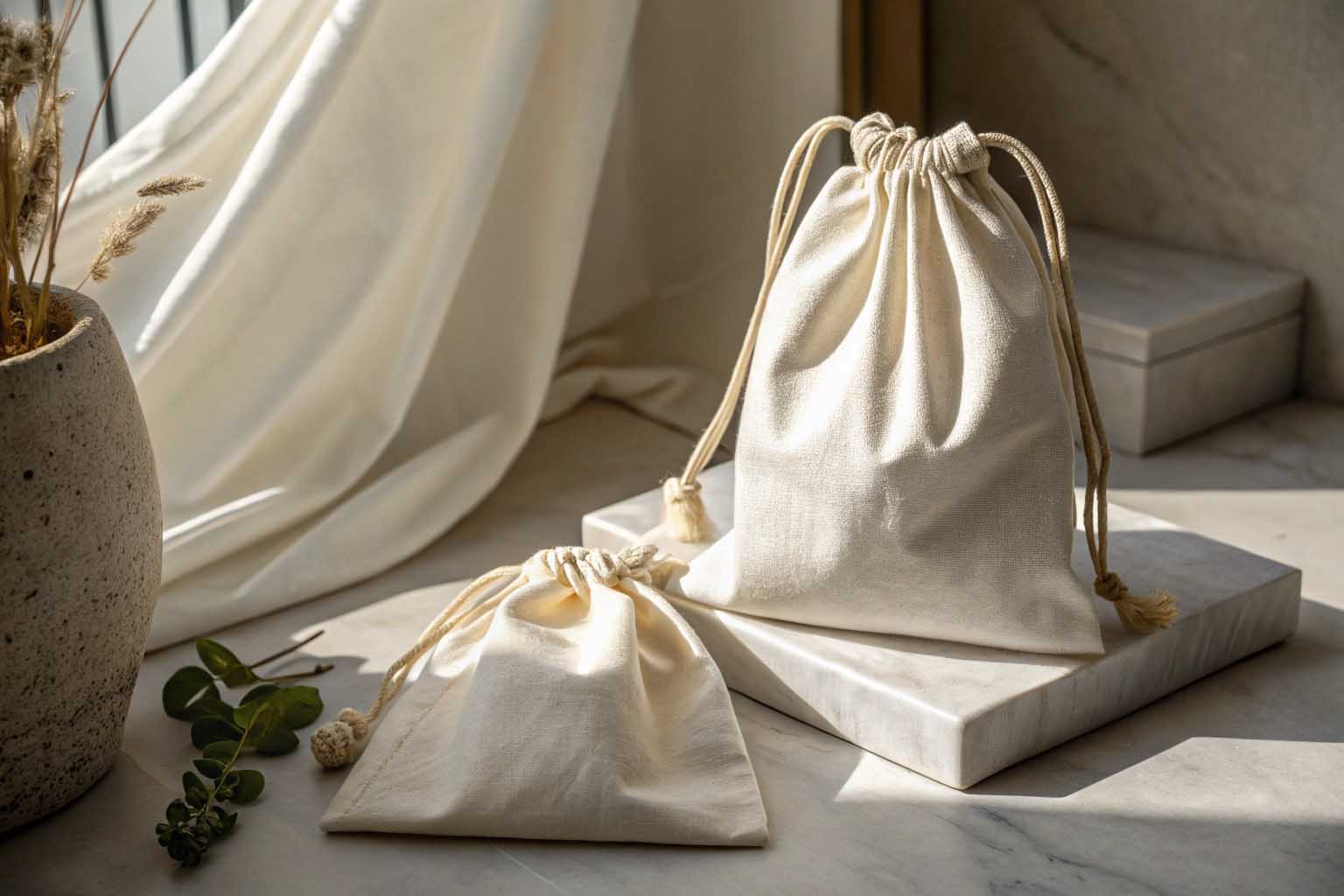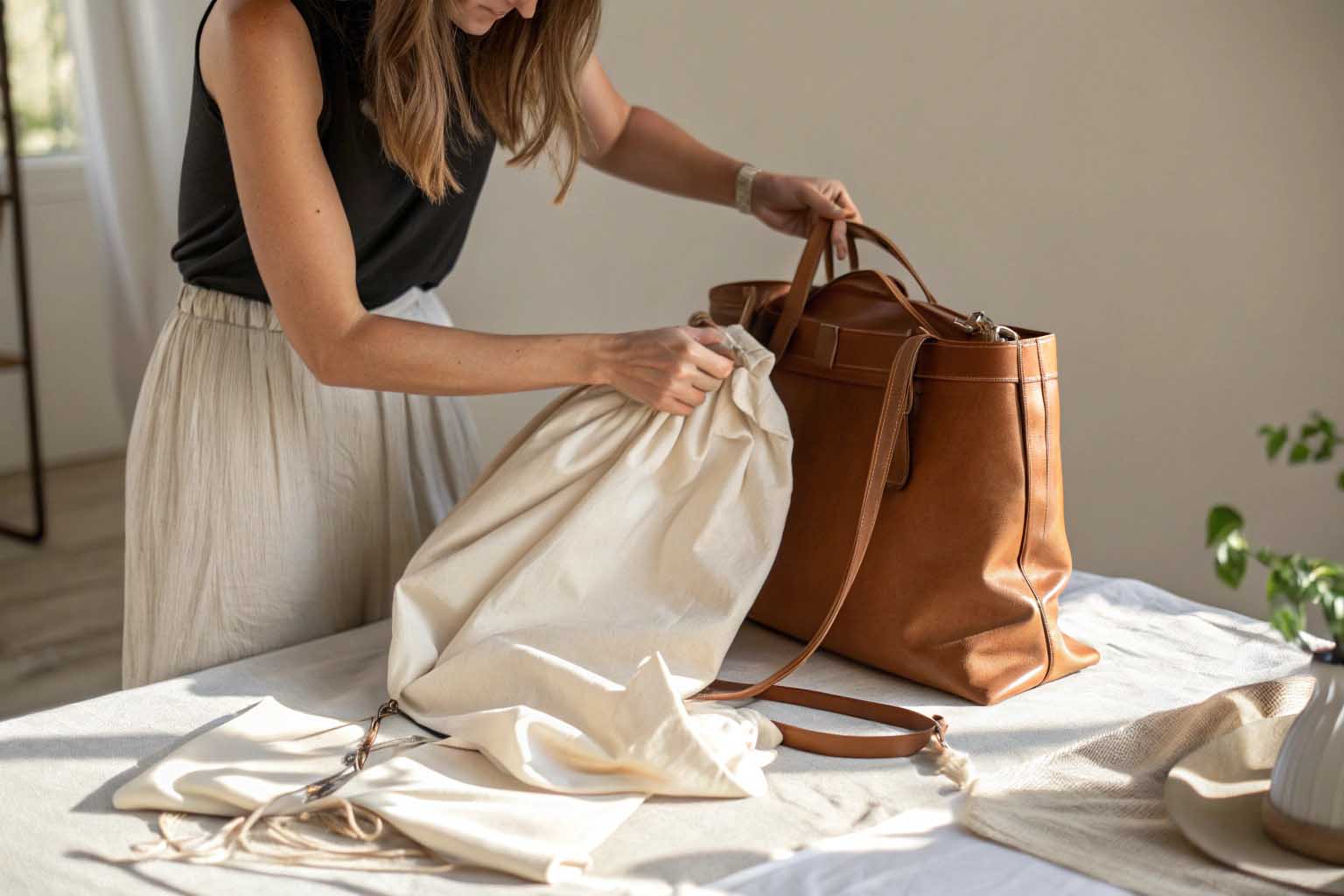Are your valuable handbags or products suffering from dust and scratches in storage? Cheap dust bags often fail, risking damage. Choosing the right protection preserves your items’ quality and value.
Selecting quality replacement dust bags means focusing on soft, breathable, non-abrasive materials like cotton flannel or microfiber. Ensure durable construction with strong seams and choose a size slightly larger than your item for easy use and full protection.

Finding the right dust bag goes beyond just grabbing any pouch. It’s about understanding the details that truly protect your items. When I first started working with suppliers, I saw firsthand how much quality can vary. Let’s dive into what features really matter, how closures compare, sizing strategies, where to find good ones, and why customization might be right for your business. Making informed choices here prevents disappointment later.
What features should you look for when purchasing replacement dust bags?
Feeling lost trying to pick the right dust bag? Worried a poor choice could actually harm your items? Focus on specific features for confident protection and peace of mind.
Key features include the material (softness, breathability, non-abrasiveness), the stitching quality (durability, especially at stress points), and the type and quality of the closure mechanism. These directly impact protection level and longevity.

Let’s break down these essential features further. Choosing the right dust bag isn’t just about looks; it’s about function. Over my years in sourcing, I’ve learned that the details make all the difference between a bag that protects and one that potentially damages.
- Material Matters: The fabric is the first line of defense.
- Softness: It must be non-abrasive to prevent micro-scratches on leather, hardware, or delicate surfaces. Think cotton flannel, brushed cotton, microfiber, or even silk blends for ultra-luxury items. Avoid rough stiff non-wovens for direct contact with sensitive surfaces.
- Breathability: Trapped moisture is an enemy of leather and can cause mildew. Natural fibers like 면 are generally more breathable than synthetics like polyester or standard non-woven polypropylene, though some synthetics are engineered for breathability.
- Construction Quality: A bag is only as strong as its seams.
- Stitching: Look for small, tight, even stitches. Double stitching, especially along the bottom and side seams and around the drawstring channel, adds significant durability. Poor stitching leads to rips and tears, defeating the purpose. I always check seam allowances and reinforcement on samples.
- Drawstring/Closure: How the bag closes is crucial.
- Drawstring Material: Ensure the drawstring itself is soft and won’t bleed color onto the bag or item. Cotton cord or a smooth ribbon is usually better than cheap synthetic rope.
- Channel: The channel holding the drawstring should be well-sewn so the string pulls smoothly without snagging or tearing the fabric.
How do different dust bag closure types affect protection quality?
Does dust still seem to sneak into your storage bags? Is the closure flimsy or hard to secure? Different closure styles offer varying levels of protection against dust and dirt.
Drawstring closures are common and effective if cinched tightly, offering good protection. Flap or zipper closures can provide a more complete seal, but ensure zippers have fabric backing to prevent scratching the contents.

The way a dust bag closes directly impacts how well it seals out the elements. While a simple drawstring is standard, it’s not the only option, and sometimes not the best depending on the storage environment. Let’s compare the common types I’ve encountered when working with manufacturers:
- Drawstring Closure:
- 장점: Simple, cost-effective, widely available, easy to use. A double drawstring (one from each side) often provides a tighter, more secure closure than a single drawstring.
- 단점: Can leave small gaps at the top if not pulled very tight, potentially allowing fine dust ingress over long periods. The quality of the channel and string matters greatly.
- Flap Closure:
- 장점: Can offer a better seal over the opening than a basic drawstring, often secured with velcro, snaps, or ties. Looks neat and tidy.
- 단점: Adds complexity and cost. Velcro can snag delicate fabrics if not carefully aligned. Snaps can be bulky.
- Zipper Closure:
- 장점: Provides the most complete seal against dust.
- 단점: Adds significant cost. Most importantly, the zipper teeth MUST be covered by a fabric placket on the inside to prevent scratching the item stored within. I’ve seen beautiful bags ruined by an exposed zipper inside a dust bag – a critical quality control point.
다음은 간단한 비교입니다:
| Closure Type | Protection Level | Ease of Use | Potential Issues | 최상의 대상 |
|---|---|---|---|---|
| Single Drawstring | Good | Very Easy | Small gaps possible | General use, less dusty environments |
| Double Drawstring | 매우 좋음 | Very Easy | Tighter closure than single | Most handbags, shoes, accessories |
| Flap (Velcro/Snap) | 매우 좋음 | 쉬운 | Velcro snagging, snap bulk | Structured items, enhanced presentation |
| Zipper | 우수 | 쉬운 | Scratching risk if not covered | Long-term storage, very dusty environments |
What sizes of dust bags work best for various handbag styles?
Is your expensive tote crammed into a tiny pouch? Or is your clutch lost inside a huge sack? Using the wrong size dust bag fails to protect properly and can even cause issues.
Measure your handbag’s length, height, and width. Select a dust bag that is roughly 1-2 inches (2-5 cm) larger in width and height to allow easy insertion and prevent strain on the bag or its seams.

Getting the size right is crucial for effective protection. Too tight, and you risk straining the dust bag’s seams or even compressing delicate parts of your handbag. Too loose, and the handbag can shift around inside, offering less protection against bumps, and the excess fabric can be cumbersome. I always advise clients to measure carefully.
Here’s a general guide based on common handbag types:
- Small Leather Goods (SLGs) & Clutches:
- Typical Dimensions: Vary greatly, but often around 8-12 inches wide.
- Dust Bag Size: Look for bags around 10-14 inches wide and appropriately tall. Ensure it’s not too deep, causing the item to slide.
- Crossbody & Small Shoulder Bags:
- Typical Dimensions: Often 8-10 inches high and 9-12 inches wide.
- Dust Bag Size: Aim for around 12-14 inches high and 14-16 inches wide. Check the depth (gusset) too.
- Satchels & Medium Totes:
- Typical Dimensions: Around 10-13 inches high and 12-15 inches wide.
- Dust Bag Size: A bag around 15-18 inches high and 17-20 inches wide often works well. Ensure enough room for handles.
- Large Totes & Travel Bags:
- Typical Dimensions: 13+ inches high and 15+ inches wide.
- Dust Bag Size: Need larger sizes, perhaps 20×20 inches or even 24×24 inches, depending on the specific bag. Consider gusseted dust bags for wider items.
Pro Tip: Always measure your specific item before buying. Lay the item flat and measure its widest and tallest points. Add at least one inch, preferably two, to each dimension for the ideal dust bag size. This small step prevents buying unusable bags – a common mistake I’ve seen people make when ordering in bulk.
Where can you find high-quality dust bags that match designer standards?
Struggling to find replacement dust bags that feel as premium as the original? Disappointed with thin, flimsy options online? Sourcing high-quality dust bags requires looking beyond generic retailers.
Seek out specialized packaging suppliers, B2B vendors focusing on promotional or storage products, or high-end organizers. These sources often prioritize material quality (like heavy cotton flannel) and construction similar to luxury brands.

Finding dust bags that truly rival the quality provided by luxury designer brands can be tricky, as those are often custom-made with specific materials. However, you can find excellent quality replacements if you know where to look. Based on my experience navigating the supply chain:
- Specialized Online Retailers: Some online stores focus specifically on storage solutions for luxury goods (handbags, shoes). They often curate higher-quality dust bags than general marketplaces, understanding the need for soft, protective materials. Search terms like "luxury dust bag," "cotton flannel dust bag," or "handbag storage solutions."
- B2B Suppliers (Like Avecobaggie): This is where you often find the best intersection of quality and value, especially if buying multiple bags. Companies specializing in custom bags and promotional products (like mine!) have access to a wide range of quality materials (various weights of cotton, microfiber) and construction techniques (double stitching, quality drawstrings). We understand protective requirements. The challenge might be meeting minimum order quantities (MOQs), but quality control is generally more rigorous.
- Etsy and Artisan Marketplaces: You can find sellers offering handmade dust bags, sometimes using very high-quality fabrics. Quality can vary significantly seller by seller, so check reviews, material descriptions, and photos carefully. This is better for buying just one or two bags.
- Directly from Brands (Sometimes): Occasionally, designer brands might sell replacement dust bags, but this is uncommon and often expensive. It’s usually not a practical option for multiple replacements.
Key takeaway: Don’t expect top quality from generic bulk listings on major e-commerce platforms unless they specify premium materials (like thick cotton flannel or microfiber) and show detailed construction. Focus on suppliers who understand the purpose of the bag – protection.
Why might custom-printed dust bags benefit small businesses and boutiques?
Think dust bags are just for protection? Want to make your customer’s experience feel more special? Custom-printed dust bags offer a powerful branding opportunity beyond the item itself.
Custom dust bags elevate the perceived value of products, reinforce brand identity every time the item is stored, and create a memorable, luxurious unboxing experience, differentiating smaller businesses.

For small businesses, boutiques, and even event organizers, investing in custom-printed dust bags can provide significant returns beyond basic product protection. It’s a detail I often recommend to clients looking to enhance their brand presentation. Here’s why it works:
- Enhanced Brand Perception: Receiving a product in a custom-logoed dust bag instantly feels more premium and intentional. It mirrors the experience offered by high-end brands, elevating the customer’s perception of 당신의 brand and product quality.
- Reinforced Branding: Every time the customer retrieves or stores their item, they see your logo. It’s a subtle, recurring reminder of your brand, extending the marketing reach long after the initial purchase or event.
- Improved Unboxing Experience: The unboxing process is a key customer touchpoint, especially for online businesses. A beautiful, branded dust bag adds a layer of luxury and care, making the experience more memorable and shareable.
- Differentiation: In a crowded market, small details matter. Custom dust bags help smaller businesses stand out, showing attention to detail and investment in the customer experience. I’ve seen this make a real impact for artisan brands.
- Practical Marketing Tool: They can include website URLs, social media handles, or care instructions, serving a dual purpose. If using sustainable materials like organic cotton, the bag itself becomes part of your eco-conscious branding message.
Considerations: There will be minimum order quantities (MOQs) and design setup costs associated with custom printing. However, working with a supplier experienced in custom bags can help navigate options like screen printing or digital printing to find a solution that fits your budget and aesthetic. The added perceived value often outweighs the incremental cost per item.
결론
Choosing quality dust bags means checking fabric, stitching, closure, and size. Find good sources or consider custom printing for branding to best protect and present your valuable items effectively.


